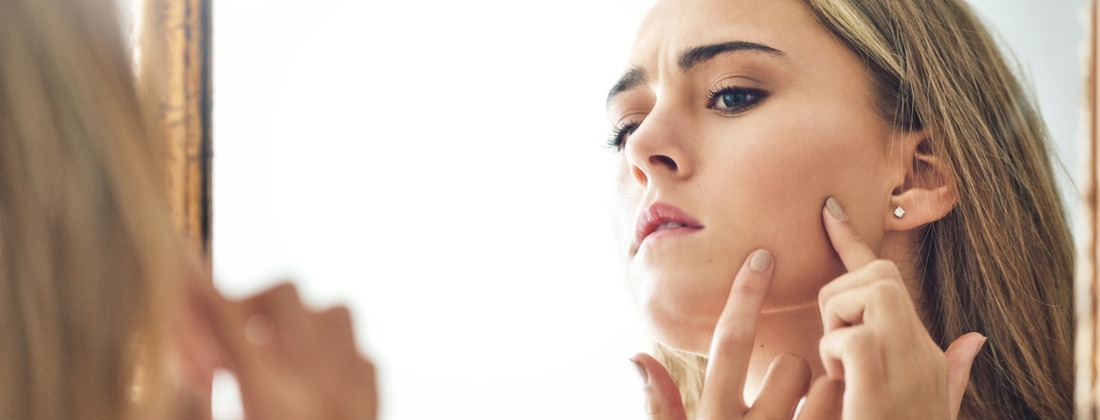
What is Rosacea? Symptoms, Treatment, and Info
Do you or a family member have Rosacea? Sometimes it can be tricky to work out why it happens and what you can do about it. Here we lay out everything you need to know about this common skin condition, and what you can do to support your body and skin to be at its best.
What is Rosacea?
This chronic skin condition characterised by the random formation of red patches, bumps and blemishes on the face, neck and in some cases the chest. It can affect any part of the head, face and neck area, though usually it is the face that is affected most. In some people it is hardly felt and in others the sensations are considerably uncomfortable. Recent estimates have revealed that it affects between 5 and 20% of the world’s population. As such it is considered a pretty big health concern.
The area of skin can also get really dry and flaky and eventually skin will start lifting and peeling off. Rosacea can worsen over time, so it is best to get on top of it by identifying your triggers and using natural rosacea creams as soon as you are able. A rare outcome of worsening rosacea on the nose can lead to a bulbous red-coloured nose also referred to as ‘rhinophyma’.
What are the 4 types of Rosacea?
There are 4 different types of Rosacea:
- Erythematotelangiectatic Rosacea (ETR) – the most common type that involves skin redness, flushing, and spider veins.
- Inflammatory Rosacea – distinctive from ETR in that along with skin redness there are bumps and pustules.
- Phymatous Rosacea – leads to a thickening of the skin on the face.
- Ocular Rosacea – affects the eyes.
What are the causes of Rosacea?
Rosacea affects more women than men (by a factor of three) and its onset is most prevalent between the ages of 30 and 60. The condition does appear to affect a disproportionately larger number of fair skinned people compared to people with more melanin pigments.
Research has shown that certain inflammatory pathways play a key role in the development of rosacea. So, addressing this is an important step in caring for this condition.
Conventional treatment includes the use of topical corticosteroids, however they are not recommended for long term use.
Food intolerances
Another one is food intolerance. Gluten, lactose, and other foods have been linked to the development of Rosacea – especially in the elderly. Certain food groups are known to stimulate the release of prostaglandins which end up dilating blood vessels in the face.
Bacterial overgrowth in the gut
Recent studies appear to suggest that the overgrowth of undesirable bacteria in the small intestines might be linked. Supplementing with probiotics and reducing refined sugars can support a healthy small intestine. Another tip for managing this is to reduce your eating window – which basically means don’t snack between dinner and breakfast. This activates your migratory motor complex which is your body’s internal sweeping mechanism for the intestines.
Mites
Did you know that we all have tiny little mites that live on our faces? Without going into too much detail, essentially rosacea on the face can potentially be traced back to having too many of these little critters. The mites themselves are not the issue, it is how many there are – and whether your body has mounted an immune response to them.
What can trigger Rosacea?
If you already have it, here are some of the common triggers to be aware of:
Sun and temperature changes
As mentioned, increased sun exposure can trigger it – especially sunburn. Also being in an environment where temperatures fluctuate greatly, can cause flushing and red patches (going from hot to cold and vice versa). In some people hot baths and saunas are definite triggers.
Worry and pressure
Some emotional states are believed to be a major contributor. Trying to create an environment that reduces your load and stressors will support your body and skin to be at its best. If you’re feeling overwhelmed or under a lot of pressure, see our 6 ways to stay balanced and look after yourself.
Food sensitivities
Identify foods that you may be sensitive to. This is a trial process that everyone has to do individually, as we are all different and our digestive tracts and immune systems are primed to different allergens and foods. Common trigger foods include: gluten, lactose, alcohol, caffeine, and spicy foods. You can check to see if one of these foods is contributing to your Rosacea by keeping a food diary.
Histamine intolerance
Some people are highly sensitive to histamine. Histamine increases capillary permeability and superficial blood vessel dilation. Some foods such as cheese (especially aged varieties), beer, red wine, yoghurt, and certain pork products (most notably bacon as it’s highly processed) are high in histamine. Next time you eat something high in histamine, make a note in your food diary to see if there is a connection.
Rosacea treatments
It is important to become aware of your triggers – and this may take some time. Stay positive and experiment, especially with your food.
Nutrition to support healthy skin
To support calm and smooth skin, research appears to suggest a diet high in nuts, seeds, fruit, whole grains, vegetables, polyunsaturated oils (olive, corn, soy, sesame, avocado oil) and oily fish (like mackerel).
- Foods high in antioxidants - cherries, artichokes, beans, broccoli, apples and (you’ll be happy to hear) dark chocolate are all high in antioxidants.
- Omega 3 fatty acids are found in oily fish, flaxseed, and hempseed. Omega 3’s are wonderful for the skin - they support calm and soothed skin. Shop our range of Superfoods
Gut health
Your gut health and your microbiome can have a huge impact on the health of your skin. A healthy gut means that you are absorbing all the nutrients from your food and have a thriving microbiome that is busy supporting your immune system – which has a direct effect on the skin.
If you’re looking for a good probiotic, try one from our Digestive Immune Support range – or if you are going all in, start with a Detox & Body Cleanse.
|
Supplements
- Vitamin C and Zinc both support skin health.
- Omega 3 fatty acids support healthy skin and appropriate immune responses in the body.
- Healthy levels of the essential amino acid Lysine supports calm and smooth skin.
- Turmeric root extract supports a balanced immune response.
- As well as getting your antioxidants from your diet, you can top up with an antioxidant supplement like Vitamin C, Glutathione, or Resveratrol.
|
Natural skin products
There are some great natural products, including rosacea cream, cleansers, and oils available to support facial flushing – products that are designed specifically for people with sensitive, redness prone, skin.
- Moroccan Argan oil has long been touted as an excellent support because of its calming effect.
- Products made from rose water are calming and restorative.
- When it comes to the skin mites, skin products that contain certain bug fighting Essential Oils will deal to them – however use them sparingly as they can be harsh on the skin.
Be sure to check for natural and organic facial cleansing products, many industrial versions of facial soaps and creams have other additives that may irritate skin.
|
Finding a solution that works for you
Every single person will have different predisposing factors, different triggers, and will respond differently to the various solutions. In order for you to find the solution that works for you, you will need to review these factors, keep a food diary, and trial different supplements and skincare products until you find your sweet spot.
It can take some time to work this out, so patience is needed. Remember it is possible to support your skin health naturally.

